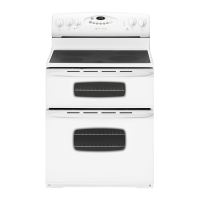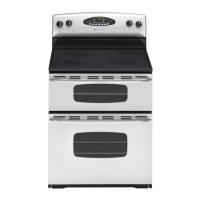Surface Cooking
Cannin
and Oversiz
ookware
ll canners and lar
e pots must have flat bottoms an
must be made
rom heavy-gauge materials.
hi
i
riti
n smoothtop surfaces. The base must not be more tha
inch larger than the element.
When canners and pots do not meet these standards, cookin
imes may
e
on
er, an
coo
tops may
e
ama
e
ome canners are designed with smaller bases for use on
smoothtop surfaces
hen canning, use the High heat setting only until the
w
t
r
m
t
b
i
or pressure is reached in the canner.
educe to t
e lowest
eat settin
t
at maintains t
e boil o
ressure. I
the heat is not turned down, the cookto
may b
ama
e
.
ookware Recommendation
Flat, smooth-bottom Pans with grooved or warped bottoms.
pans. Pans with uneven bottoms do not cook
e
icientl
and sometimes ma
not
boil liquid
Heavy-gauge pans. Very thin-gauge metal or glass pans.
m
r
larger than the
same size as the element by 1 inch.
m
nt
Secure handles. Cookware with loose or broken handles.
Heavy
andles t
at tilt t
e
an.
Tight-fitting lids. Loose-fitting lids.
Flat bottom woks. Woks with a ring-stand bottom.
sing the right cookware can prevent many problems, such
as
ood takin
lon
er to cook or achievin
inconsistent
resu
ts.
roper pans wi
re
uce coo
ing times, use
ess
energy, and cook food more evenly.
t
n
t
See if your pans are flat
he Ruler Test:
. Place a ruler across the bottom of the pan.
. Hold it up to t
e li
t.
3. Little or no light should be visible under the ruler.
he Bubble Test:
. Put 1 inch o
water in the
an. Place on cookto
and turn
ntr
t
ig
.W
t
h th
f
rm
ti
n
f th
l
th
w
t
r h
t
.
ni
orm bubbles mean good per
ormance, and uneve
ubbles indicate
ot spots and uneven cookin
.

